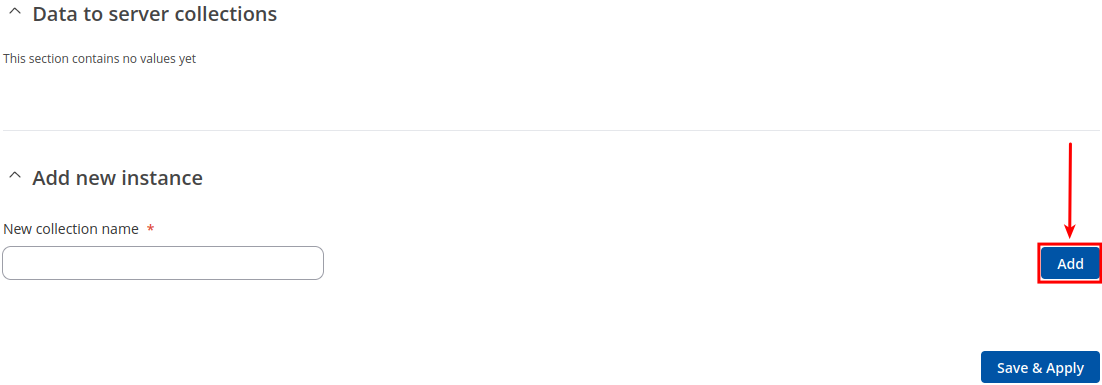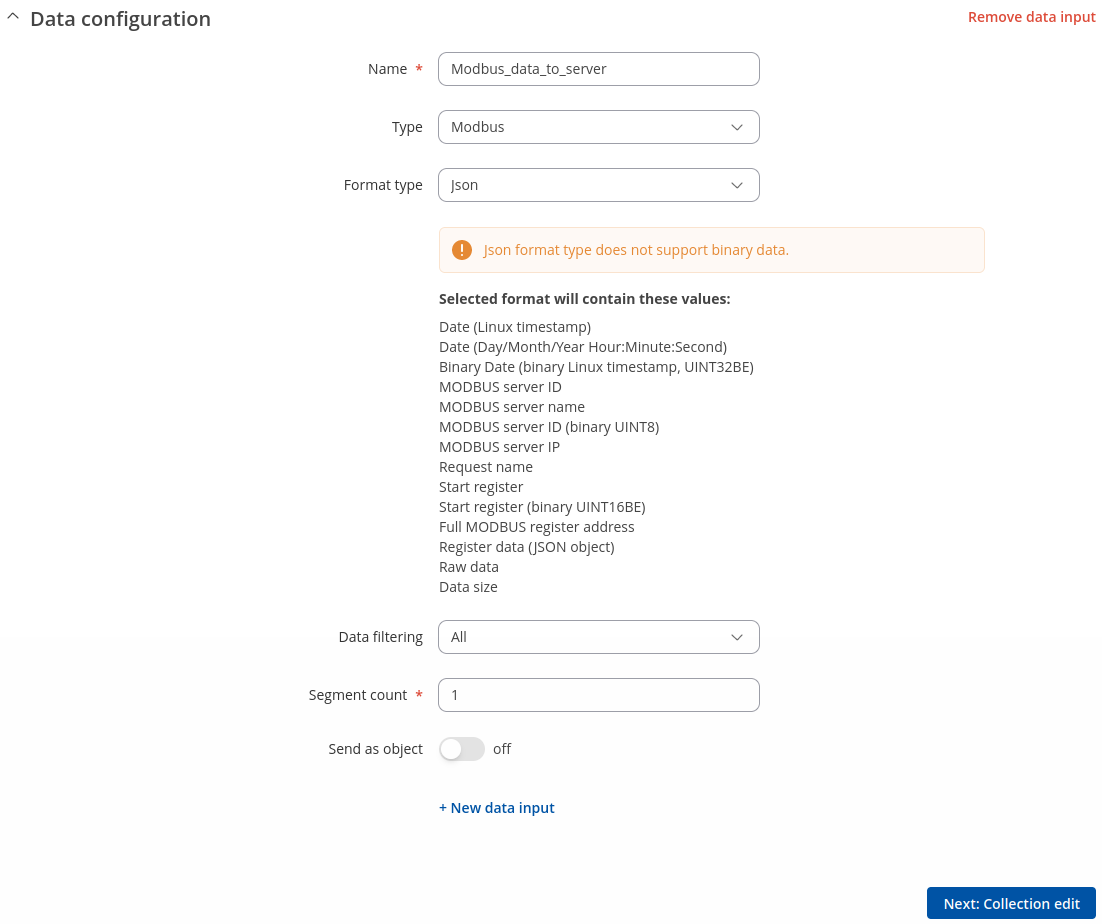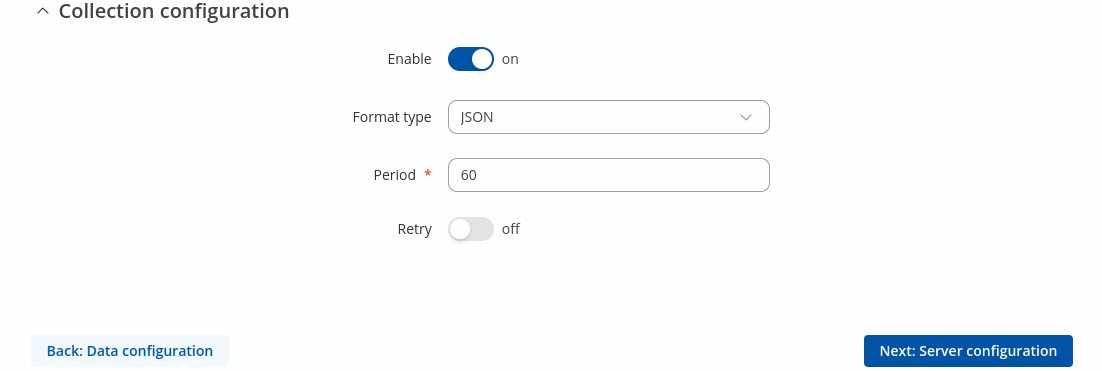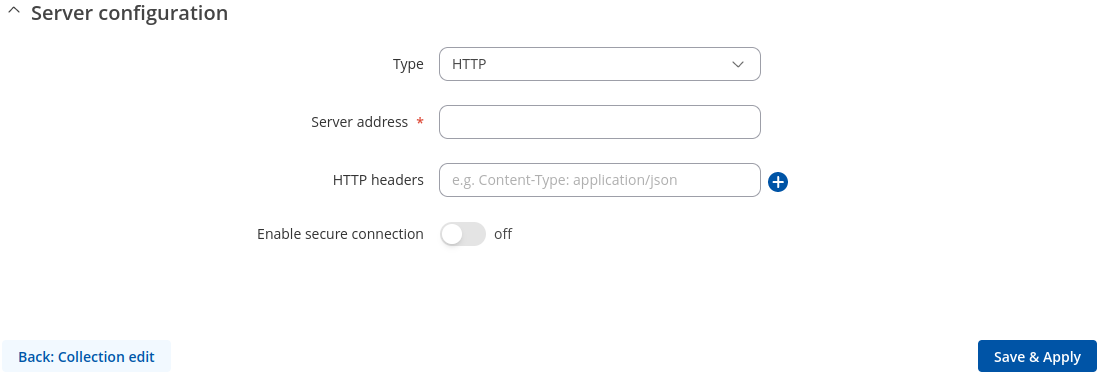Template:Networking rutos manual data to server: Difference between revisions
No edit summary |
No edit summary |
||
| (4 intermediate revisions by the same user not shown) | |||
| Line 73: | Line 73: | ||
<tr> | <tr> | ||
<td>Type</td> | <td>Type</td> | ||
<td><span>Base {{!}} {{#ifeq:{{{bluetooth}}}|1|<span style="color:green">Bluetooth</span> {{!}} |}}{{#ifeq:{{{mobile}}}|1| GSM {{!}} |}} {{#ifeq:{{{mobile_usage}}}|1|<span style="color:blue">Mobile usage</span>{{!}} |}}{{#ifeq:{{{MNF}}}|1|MNF info{{!}} |}}{{#ifeq:{{{Modbus}}}|1| <span style="color:red">Modbus</span><span class="asterisk">*</span> {{!}} <span style="color:grey">Modbus Alarms</span> {{!}} |}}{{#ifeq:{{{wifi}}}|1|<span style="color:purple">Wifi scanner</span><span class="asterisk">*</span> {{!}} |}}{{#ifeq:{{{DNP3}}}|1|<span style="color:brown">DNP3</span><span class="asterisk">*</span> {{!}} |}}{{#ifeq:{{{MQTT}}}|1|<span style="color:orange">MQTT</span> {{!}} |}} {{#ifeq:{{{OPC}}}|1|<span style="color:lightblue">OPC UA</span> {{!}} |}}{{#ifeq:{{{DLMS}}}|1|<span style="color:hotpink">DLMS</span><span class="asterisk">*</span> | <td><span>Base {{!}} {{#ifeq:{{{bluetooth}}}|1|<span style="color:green">Bluetooth</span> {{!}} |}}{{#ifeq:{{{mobile}}}|1| GSM {{!}} |}} Lua script {{!}} {{#ifeq:{{{mobile_usage}}}|1|<span style="color:blue">Mobile usage</span>{{!}} |}}{{#ifeq:{{{MNF}}}|1|MNF info{{!}} |}}{{#ifeq:{{{Modbus}}}|1| <span style="color:red">Modbus</span><span class="asterisk">*</span> {{!}} <span style="color:grey">Modbus Alarms</span> {{!}} |}}{{#ifeq:{{{wifi}}}|1|<span style="color:purple">Wifi scanner</span><span class="asterisk">*</span> {{!}} |}}{{#ifeq:{{{DNP3}}}|1|<span style="color:brown">DNP3</span><span class="asterisk">*</span> {{!}} |}}{{#ifeq:{{{MQTT}}}|1|<span style="color:orange">MQTT</span> {{!}} |}} {{#ifeq:{{{OPC}}}|1|<span style="color:lightblue">OPC UA</span> {{!}} |}}{{#ifeq:{{{DLMS}}}|1|<span style="color:hotpink">DLMS</span><span class="asterisk">*</span>|}}; default: <b>Base</b></span> | ||
</td> | </td> | ||
<td>Source of the data to be sent to server.</td> | <td>Source of the data to be sent to server.</td> | ||
| Line 174: | Line 174: | ||
</tr> | </tr> | ||
|}} | |}} | ||
<tr> | {{#ifeq:{{{MQTT}}}|1|<tr> | ||
<td><span style="color:orange">Server address</span></td> | <td><span style="color:orange">Server address</span></td> | ||
<td>Default: <b>empty</b></td> | <td>Default: <b>empty</b></td> | ||
| Line 259: | Line 259: | ||
<tr> | <tr> | ||
<td><span style="color:orange">Require password</span></td> | <td><span style="color:orange">Require password</span></td> | ||
<td>on | <td>on {{!}} off; default: <b>off</b></td> | ||
<td>Enables password for authentication.</td> | <td>Enables password for authentication.</td> | ||
</tr> | </tr> | ||
| Line 266: | Line 266: | ||
<td>string; default: <b>none</b></td> | <td>string; default: <b>none</b></td> | ||
<td>Password used in authentication.</td> | <td>Password used in authentication.</td> | ||
</tr> | </tr>}} | ||
</table> | </table> | ||
<br> | <br> | ||
| Line 289: | Line 289: | ||
<tr> | <tr> | ||
<td>Format type</td> | <td>Format type</td> | ||
<td> | <td>JSON {{!}} <span style="color:red">custom</span>; default: <b>JSON</b></td> | ||
<td>Data collection objects formatting.</td> | <td>Data collection objects formatting.</td> | ||
</tr> | </tr> | ||
| Line 337: | Line 337: | ||
<tr> | <tr> | ||
<td>Type</td> | <td>Type</td> | ||
<td>HTTP {{!}} <span style="color:red">MQTT</span>; default: <b>HTTP</b></td> | <td>HTTP {{#ifeq:{{{MQTT}}}|1|{{!}} <span style="color:red">MQTT</span>}}; default: <b>HTTP</b></td> | ||
<td>Interval in seconds for collecting/sending data to destination.</td> | <td>Interval in seconds for collecting/sending data to destination.</td> | ||
</tr> | </tr> | ||
| Line 355: | Line 355: | ||
<td>Enables the use of TLS certificates.</td> | <td>Enables the use of TLS certificates.</td> | ||
</tr> | </tr> | ||
{{#ifeq:{{{MQTT}}}|1| | |||
<tr> | <tr> | ||
<td><span style="color:red">Port</span></td> | <td><span style="color:red">Port</span></td> | ||
| Line 383: | Line 383: | ||
* 1 - when we want the message to arrive at least once but don't care if it arrives twice (or more), | * 1 - when we want the message to arrive at least once but don't care if it arrives twice (or more), | ||
* 2 - when we want the message to arrive exactly once. A higher QoS value means a slower transfer.</td> | * 2 - when we want the message to arrive exactly once. A higher QoS value means a slower transfer.</td> | ||
</tr> | </tr>}} | ||
<tr> | <tr> | ||
<td>Enable secure connection</td> | <td>Enable secure connection</td> | ||
<td>off {{!}} <span style="color:blue">on</span>; default: '''off'''</td> | <td>off {{!}} <span style="color:blue">on</span>; default: '''off'''</td> | ||
<td>Enables the use of TLS certificates.</td> | <td>Enables the use of TLS certificates.</td> | ||
</tr> | </tr>{{#ifeq:{{{MQTT}}}|1| | ||
<tr> | <tr> | ||
<td> | <td>Allow insecure connection</td> | ||
<td>off {{!}} on; default: '''off'''</td> | <td>off {{!}} on; default: '''off'''</td> | ||
<td>Allow not verifying server authentication.</td> | <td>Allow not verifying server authentication.</td> | ||
</tr> | </tr>}} | ||
<tr> | <tr> | ||
<td> | <td><span style="color:blue">Certificate files from device</span></td> | ||
<td>off {{!}} on; default: '''off'''</td> | <td>off {{!}} on; default: '''off'''</td> | ||
<td>Specify where the certificates will be used from.</td> | <td>Specify where the certificates will be used from.</td> | ||
</tr> | </tr> | ||
<tr> | <tr> | ||
<td>Certificate | <td><span style="color:blue">Certificate authority file</span></td> | ||
<td>.ca file; default: <b>none</b></td> | <td>.ca file; default: <b>none</b></td> | ||
<td>'''Certificate authority''' is an entity that issues digital certificates. A digital certificate certifies the ownership of a public key by the named subject of the certificate.</td> | <td>'''Certificate authority''' is an entity that issues digital certificates. A digital certificate certifies the ownership of a public key by the named subject of the certificate.</td> | ||
</tr> | </tr> | ||
<tr> | <tr> | ||
<td> | <td><span style="color:blue">Client Certificate</span></td> | ||
<td>.crt file; default: <b>none</b></td> | <td>.crt file; default: <b>none</b></td> | ||
<td>Certificate file is a type of digital certificate that is used by client systems to make authenticated requests to a remote server. If client certificate is not needed, leave both client certificate and client key fields empty.</td> | <td>Certificate file is a type of digital certificate that is used by client systems to make authenticated requests to a remote server. If client certificate is not needed, leave both client certificate and client key fields empty.</td> | ||
</tr> | </tr> | ||
<tr> | <tr> | ||
<td> | <td><span style="color:blue">Client Private Keyfile</span></td> | ||
<td>.key file; default: <b>none</b></td> | <td>.key file; default: <b>none</b></td> | ||
<td>File containing private key for this client. This file needs to be not encrypted.</td> | <td>File containing private key for this client. This file needs to be not encrypted.</td> | ||
</tr> | </tr>{{#ifeq:{{{MQTT}}}|1| | ||
<tr> | <tr> | ||
<td>Use credentials</td> | <td>Use credentials</td> | ||
| Line 443: | Line 428: | ||
<td>string; default: <b>none</b></td> | <td>string; default: <b>none</b></td> | ||
<td>Password used in authentication.</td> | <td>Password used in authentication.</td> | ||
</tr> | </tr>}} | ||
</table> | </table> | ||
[[Category:{{{name}}} Services section]] | [[Category:{{{name}}} Services section]] | ||
Latest revision as of 12:47, 23 July 2024
The information in this page is updated in accordance with firmware version .
Summary
The Data to Server feature provides you with the possibility to set up data senders that collect data from various sources and periodically send it to remote servers.
Note: On {{{name}}}, Data to Server is additional software that can be installed from the System → [[{{{name}}} Package Manager|Package Manager]] page.
If you're having trouble finding this page or some of the parameters described here on your device's WebUI, you should turn on "Advanced WebUI" mode. You can do that by clicking the "Advanced" button, located at the top of the WebUI.
Data Senders
A Data Sender is an instance that gathers and periodically sends collected data to a specified server. The Data Senders list is empty by default so, in order to begin configuration you must add a new data sender first. To add a new data sender, click the 'Add' button.
After this you should be redirected to the newly added data sender's configuration page.
Sender Settings
Refer to the table below for descriptions on data sender configuration fields.
Note: these tables have coloring schemes to indicate which fields can be seen with different configuration.
General
| Field | Value | Description |
|---|---|---|
| Name | string; default: none | Name of the data sender. Used for easier data senders management purposes only (optional). |
| Type | Base | Lua script | ; default: Base | Source of the data to be sent to server. |
| Format type | Json | Custom; default: Json | Arranges the format of the sent JSON segment. |
| Format string | string; default: none | Specifies custom format string. |
| Empty value | string; default: N/A | A string which will be placed if any value cannot be received. |
| Delimeter | string (Maximum length of value is 1 bytes); default: N/A | Specifies delimiters for multiple data segments. |
| Segment count | integer [1..64]; default: 1 | Max segment count in one JSON string sent to server. |
| Send as object | off | on; default: off | When turned on, sends JSON segment as object and not as an array element. |
* This is additional software that can be installed from the System → [[{{{name}}} Package Manager|Package Manager]] page.
Collection settings
| Field | Value | Description |
|---|---|---|
| Enabled | off | on; default: on | Enables data to server collection instance. |
| Format type | JSON | custom; default: JSON | Data collection objects formatting. |
| Format string | Default: Instance name | Specifies custom format string |
| Empty value | Default: N/A | A string which will be placed if any value cannot be received |
| Period | Default: 60 | Interval in seconds for collecting/sending data to destination. |
| Retry | off | on; default: off | In case of a failed attempt, retry to send the same data to destination later. |
| Retry count | Default: 10 | Retry to send the same data N times |
| Timeout | Default: 1 | Timeout in second between retry attempts |
Server configuration
| Field | Value | Description |
|---|---|---|
| Type | HTTP ; default: HTTP | Interval in seconds for collecting/sending data to destination. |
| Server address | Default: empty | Hostname or IP address of the broker to connect to. |
| HTTP headers | Default: empty | Allows to add custom headers to the HTTP requests. |
| Enable secure connection | on | off; default: off | Enables the use of TLS certificates. |
| Enable secure connection | off | on; default: off | Enables the use of TLS certificates. |
| Certificate files from device | off | on; default: off | Specify where the certificates will be used from. |
| Certificate authority file | .ca file; default: none | Certificate authority is an entity that issues digital certificates. A digital certificate certifies the ownership of a public key by the named subject of the certificate. |
| Client Certificate | .crt file; default: none | Certificate file is a type of digital certificate that is used by client systems to make authenticated requests to a remote server. If client certificate is not needed, leave both client certificate and client key fields empty. |
| Client Private Keyfile | .key file; default: none | File containing private key for this client. This file needs to be not encrypted. |
[[Category:{{{name}}} Services section]]





